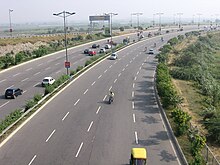| Expressways of India | |
|---|---|
 | |
| System information | |
| Maintained by Ministry of Road Transport and Highways | |
| Length | 5,930 km (3,680 mi) |
| Formed | 2002 |
| Highway names | |
| System links | |



Expressways are the highest class of roads in India. In July 2023, the total length of expressways in India was 5,930 km (3,680 mi), with 11,127.69 km (6,914.43 mi) under construction. These are controlled-access highways where entrance and exits are controlled by the use of cloverleaf, three-way, trumpet or grade separated interchanges that are incorporated into the design of the expressway and designed for maximum speed of 120 km/h, whereas National highways are flyover access or tolled, where entrance and exit is through the side of the flyover, at each intersection of highway with road, flyovers are provided to bypass the city/town/village traffic and these highways are designed for speed of 100 km/h. Some roads are not access-controlled expressways but are still named expressways, such as the Bagodara–Tarapur Expressway,[1] Biju Expressway,[2] these are actually state highways that are not declared by the central government as an Expressway, hence not an Expressway or National Highway.
Under construction, the Delhi–Mumbai Expressway will be the longest expressway in India. It is expected to be completed by the end of 2025.
Mumbai–Pune Expressway is the first 6-lane operational expressway in India started in 2002. Expressways follow standards set by Indian Roads Congress and Bureau of Indian Standards.
Currently, the longest expressway in India is the partially-opened Delhi–Mumbai Expressway (Phase-III) at 935 km (581 mi), which was opened in 2023,[3] and the widest expressway is the Delhi – Gurgaon section of the Dwarka Expressway with 16 lanes, which was opened in 2024.
- ^ Translink Infrastructure Consultants (27 February 2023). Six Laning of Bagodara Tarapur Section. Retrieved 24 May 2024 – via YouTube.
- ^ "Biju Expressway Route Map, Cost, Progress, and More - Infra Info Hub". 17 January 2024. Retrieved 3 February 2024.
- ^ "Mumbai-Nagpur Expressway: CM Shinde, Dy CM Fadnavis Launch Phase-2 of Samruddhi Mahamarg". 26 May 2023.